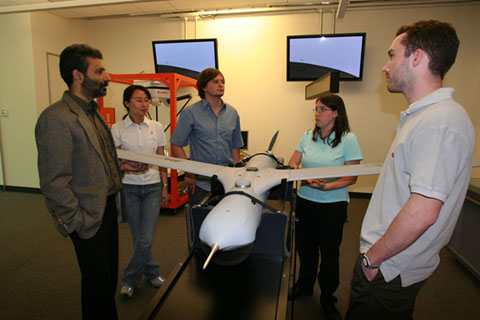Student Ambassadors for Open Source
 CT: Why did Sun Microsystems establish a Campus Ambassador Program that centers around open source?Bahal:
CT: Why did Sun Microsystems establish a Campus Ambassador Program that centers around open source?Bahal: In order for computer science or IT people to be successful, a lot today is based around open source. At Sun we've taken billions of dollars of intellectual property and open sourced it. If you look at three big things, Java, Solaris (which is the operating system that competes with Linux), and SPARC (which is the chip)--we've open sourced all of that. So our message is, for [these students] to be successful at work, they've got to understand how to utilize the open source technologies, how to work in the communities associated with that, and how to give back to the communities. [See photo, left to right: Dinesh Bahal with campus ambassadors from China (Rita Zhang), Russia (Filipp Shubin), USA (Kira Morrow), and Brazil (Rafael Vanoni) in Sun's Executive Briefing Center in Menlo Park, CA. Photo by Mary Grush.]
What's the nature of the collaboration this program fosters among these international students?Part of the reason we care so much about open source is not just getting people involved, but more importantly that it provides an instant feedback mechanism to the product groups. Let me give you an example. One of the most active Open Solaris user groups is in Brazil. They have a really active community, and that community may be porting [code] from, let's say Linux to Solaris. It starts appearing on the Open Solaris Web site, and I think there's almost a ratio of 1:10 of the number of people who are contributing code to the number of people who are telling what they want to see in the code. So, now we have a conversation [directly] between the engineers and the users, which in the past would go from engineer, to product marketing, to customer, and back: The layers between the engineer and the user are disappearing. What used to be a five- or six-layer mechanism is down to a virtually zero-layer mechanism.
The minute you get that type of conversation going, you get products that are more relevant to the customer, more relevant to the end-user. And because you have this transparency, the quality of the technology improves--because it's not just one engineer and a review cycle, it's people from all over the world looking at this. Also that transparency [speeds up] the cycle time of what people are trying to do.
What technologies impact this kind of communication, globally?Sun was one of the first few companies to open up blogging, and we have one of the most actively read blogs in the form of our CEO, Jonathan Schwartz's blog. I don't have the exact number--but I think an additional 3,000 people at Sun are now blogging. So it's a significant number of the employees that are blogging. And their blogging is most importantly about product directions.
What types of openness impact the environment in which these students will work?When you look at the open movement, it's at three levels. First, there's an open standards issue--for example, if I'm a public entity, why do I need someone to go buy something to access documents? Then, there's an open source issue--not everything will be open sourced, there will still be some room out there for proprietary software. But, companies that don't open source a significant part of their intellectual property are probably going to face challenges because the world is demanding that level of transparency. The third thing--and I think this is something that is really going to change education--is open content. So a teacher may say, "Look, I really want chapter one from the McGraw Hill book, and chapter two from another book, and chapter three from yet another book... and I want to be able to mix the best of all of this." And I think also that open content is going to be not only the ability to mix and match, but also that teachers all around the world will be creating and [sharing content in ways that will make it less expensive]--I think the developing world is going to start that trend initially, and it's really going to change all of the publishing industry. So, I think open standards, open source, and open content are going to be the three things around this whole openness that are going to drive probably the next few years, and companies that don't get onto that bandwagon and figure out how to make money around it are going to have challenges.
What do you see for the future of Sun's Campus Ambassador Program?We want to try to expand the program in terms of its global reach, not just in geographical distribution, but from an institutional perspective as well. We have targeted universities where we want to have ambassadors, where we think it's really important for Sun to have a presence, and where we think that the students would get a significant benefit from having someone talk about open source. So, (a) growth, (b) distribution, and (c) a question we are looking at internally: How do we make materials more available to students? How do we create more content that makes open source more acceptable to someone teaching traditional classes? For example, if someone is teaching operating system design, how can they use materials in the public domain to teach those same concepts, and ideally do that with open source software? So at Sun, we want to make investments in open content.
Dinesh Bahal is Regional Director, International Global Government, Education, and Life Sciences at Sun Microsystems.
About the Author
Mary Grush is Editor and Conference Program Director, Campus Technology.